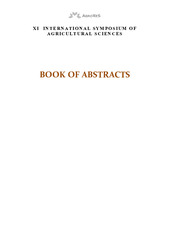Приказ основних података о документу
Analysis of local Serbian wheat varieties and landraces as a new source of variability for breeding
| dc.creator | Mikić, Sanja | |
| dc.creator | Mirosavljević, Milan | |
| dc.creator | Brbaklić, Ljiljana | |
| dc.creator | Aćin, Vladimir | |
| dc.creator | Jevtić, Radivoje | |
| dc.creator | Živančev, Dragan | |
| dc.date.accessioned | 2022-06-01T12:36:25Z | |
| dc.date.available | 2022-06-01T12:36:25Z | |
| dc.date.issued | 2022 | |
| dc.identifier.isbn | 978-99938-93-81-3 | |
| dc.identifier.uri | http://fiver.ifvcns.rs/handle/123456789/2801 | |
| dc.description.abstract | Intensive agriculture led to reduction of crops diversity, resulting in a loss of their genetic and nutritional values. Old wheat varieties and landraces, which are considered to be a significant source of genetic variability and potentially important for addressing challenges related to climate change, have almost vanished from farmers' fields. To estimate performances of wheat genetic resources, 20 local varieties and 20 landraces from Serbia collected within a project funded by the Benefit-Sharing Fund of the International Treaty on Plant Genetic Resources for Food and Agriculture were analysed in a field trial. Early vigour, winter hardiness, heading time, disease resistance, lodging resistance, chlorophyll content, normalized difference vegetation index (NDVI), plant height, protein content and grain yield of the two groups were investigated and compared at Rimski šančevi, Serbia in 2020/21. Significant phenotypic variations of all traits were found. Wheat landraces had significantly higher protein content and were more resistant to powdery mildew than the old cultivars, but had less early vigour, less winter hardiness, higher stems prone to lodging and lower yield. There were no significant differences between varieties and landraces in chlorophyll content, NDVI, resistance to Septoria leaf blotch, leaf and yellow rusts. | sr |
| dc.language.iso | en | sr |
| dc.publisher | Banja Luka : University of Banja Luka, Faculty of Agriculture | sr |
| dc.rights | openAccess | sr |
| dc.rights.uri | https://creativecommons.org/licenses/by/4.0/ | |
| dc.source | Book of Abstracts, 11th International Symposium of Agricultural Sciences “AgroReS 2022", 26-28 May 2022, Trebinje, Bosnia and Herzegovina | sr |
| dc.subject | diversity | sr |
| dc.subject | landraces | sr |
| dc.subject | phenotyping | sr |
| dc.subject | Triticum aestivum | sr |
| dc.subject | varieties | sr |
| dc.subject | wheat | sr |
| dc.subject | Serbia | sr |
| dc.subject | variability | sr |
| dc.subject | breeding | sr |
| dc.title | Analysis of local Serbian wheat varieties and landraces as a new source of variability for breeding | sr |
| dc.type | conferenceObject | sr |
| dc.rights.license | BY | sr |
| dc.citation.epage | 76 | |
| dc.citation.spage | 75 | |
| dc.identifier.fulltext | http://fiver.ifvcns.rs/bitstream/id/7748/mikic.pdf | |
| dc.identifier.rcub | https://hdl.handle.net/21.15107/rcub_fiver_2801 | |
| dc.type.version | publishedVersion | sr |


